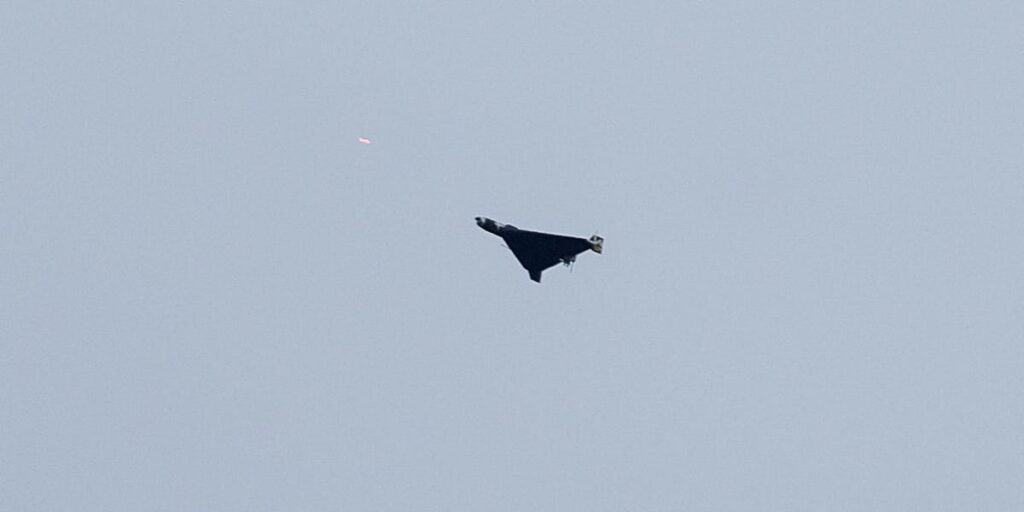The People’s Liberation Army has released brief footage of an ASN-301 drone being fired from a truck-based multiple launch system, offering a rare glimpse of the Chinese munition in action.
State media outlet CCTV aired the video on Sunday, describing the live-fire exercise as training for newly recruited drone operators.
The clips, seen by Business Insider, show two 6×6 trucks in desert terrain. Each is mounted with launchers that appear to feature six canisters for firing drones.
The ASN-301, a delta-wing drone, is seen rocketing forth from a launcher and climbing sharply in a straight flight pattern.
After showing several seconds of the drone in flight, CCTV cuts to a shot of the loitering munition diving into its target — seemingly a mock airfield with a nearby shelter — and detonating.
The clips have since circulated on international social media.
A striking resemblance to an Israeli drone
The ASN-301’s shape and design resemble the Iranian Shahed-136, but it shares more similarities with Israel’s Harpy loitering munition.
China’s drone is widely believed to be modeled after the Harpy. Unlike the Shahed, which was built as a general one-way attack drone, the ASN-301 and Harpy are both meant to detect radio frequencies that can help them target enemy air defenses.
Beijing purchased 100 Harpy drones from Israel Aerospace Industries in the 1990s. The US, concerned that shared sensitive technology might end up in Chinese hands, later pressured Israel to stop upgrading that batch of drones.
Eventually, the ASN-301 began appearing at defense exhibitions around 2017. It was marketed by China National Aero-Technology Import & Export Corporation, or CATIC, which said the eight-foot-long drone can be remotely piloted or operate fully autonomously.
CATIC said at the time that the ASN-301, known within China as the JSW-01 or the Flying Dragon 300A, can fly for four hours and scan for radio frequencies up to 15.5 miles away.
The drone itself is supposed to fly at up to 136 mph, weigh 440 pounds, and travel up to 170 miles.
The Taiwan Strait is roughly 110 miles wide, while Taiwan’s main island spans nearly 90 miles at its widest point. Thus, if launched from mainland China, the ASN-301 can likely reach the greater Taipei area.
CCTV’s Sunday report on the ASN-301 did not mention Taiwan. However, it said the live-fire exercise was carried out by a brigade of the Eastern Theater Command, which is China’s primary Taiwan-facing military force.
The China North Industries Corporation, a state conglomerate that builds launchers and armored vehicles, previously showed a partially animated promotional clip of the ASN-301 being fired from a similar launcher mounted on a 6×6 chassis.
The video, published in November 2024, shows that the ASN-301 is propeller-driven and sports a bulbous nose.
Shahed-like drones are gaining attention
Delta-wing drones have especially entered the spotlight in recent years with Russia’s increased use of the Shahed, which is originally of Iranian design but is now produced locally by the Kremlin.
Dubbed the Geran-2, the Russian version of the loitering munition has been a core part of the Kremlin’s regular bombardments of Ukraine. Moscow’s favored tactic is to launch hundreds of these cheap one-way attack drones and decoys in a single night to overwhelm air defenses.
If produced en masse, the Geran-3, Russia’s version of the jet-powered Shahed-236, stands to be a greater threat. A Russian general once boasted that it can fly 500 mph, compared to the Geran-2’s 115 mph.
Ukraine, meanwhile, has adopted an improvised air defense system that combines small arms fire, anti-air quadcopters, and expensive missile interceptors to counter the Shahed threat.
The drone war there has reshaped how the world’s militaries are now thinking about air defense and battlefield tactics. Taiwan, for example, said this summer that it plans to buy nearly 100,000 military drones, including tens of thousands of small quadcopters like the ones used in Ukraine.
Read the full article here
















